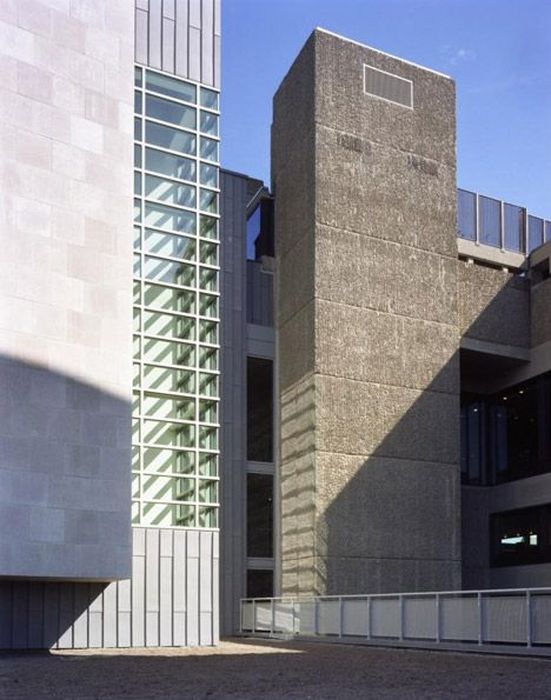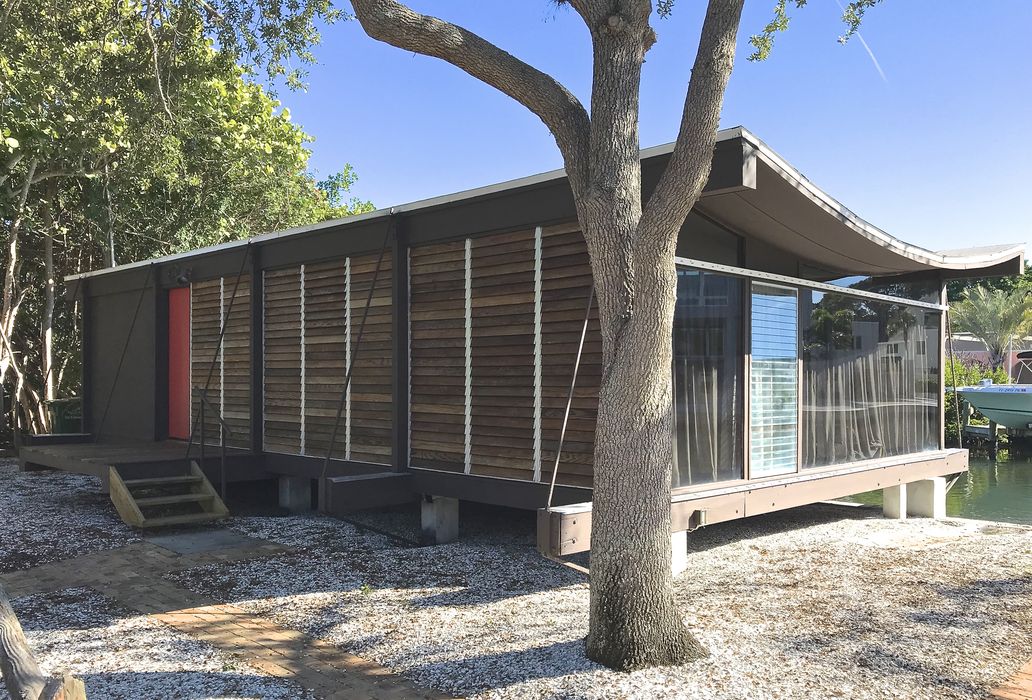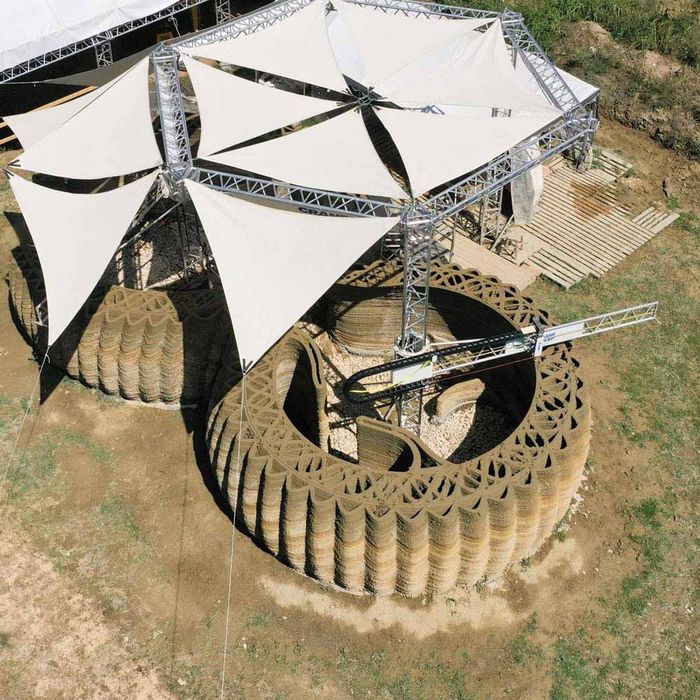
Charles R. Goulding and Preeti Sulibhavi explore Paul Rudolph’s pioneering Brutalist architecture, connecting his bold materiality and design with today’s advances in 3D concrete printing.
Paul Rudolph, celebrated as a Modernist and Brutalist architect, left an indelible mark on 20th-century architecture through his innovative use of materials and bold design principles. His contributions to architecture, recently highlighted in the “Materialized Space” exhibition at the Metropolitan Museum of Art (The Met), showcase his pioneering approach to building spaces that challenge conventional ideas of form, material, and function.
Educational and Early Professional Background
Rudolph, born in 1918 in Kentucky, pursued his architectural studies at Auburn University before advancing to the Harvard Graduate School of Design, where he studied under Walter Gropius. Gropius, a leading figure of the Bauhaus movement, influenced Rudolph’s early adoption of Modernist principles. However, Rudolph soon diverged, seeking more expressive, material-focused architecture that departed from Modernism’s purist aesthetic. His early collaboration with architect Ralph Twitchell in Sarasota, Florida, helped solidify his reputation, blending Modernist fundamentals with regional characteristics in what became known as the Sarasota School of Architecture.

Key Architectural Works: Materialized Space and Cocoon House
Rudolph’s “Materialized Space” at the Met museum is a fitting retrospective, spanning the many facets of his career. It includes notable projects like the Walker Guest House in Sanibel, Florida, which demonstrated his early exploration of modularity and prefabrication, and the Cocoon House in Sarasota, a groundbreaking residential design that used military-grade polymer to create a weather-resistant, curved roof. This structure not only exemplified Rudolph’s innovative use of materials but also highlighted his desire to blend indoor and outdoor spaces harmoniously.
The Cocoon House, also known as the Healy Guest House, utilized materials in non-traditional ways to fit the local climate and environment, incorporating concrete pylons and a distinctive catenary roof sprayed with vinyl plastic to create a unique, airy structure. This project foreshadowed Rudolph’s later experimentation with robust materials and unconventional forms, eventually leading to his embrace of Brutalism.
The Brutalist Aesthetic and “Rugged Concrete”
Brutalism, emerging in the post-war years, is often associated with exposed concrete and raw, geometric forms, echoing both the monumental and utilitarian. Rudolph’s signature Brutalist projects reflect this philosophy, particularly his work on the Yale Art and Architecture (A&A) Building. Completed in 1963, the A&A Building stands as one of his most iconic works. Its rugged concrete facade, deeply etched and textured, is emblematic of Rudolph’s philosophy that architecture should evoke a visceral response. The building’s dramatic interplay of light and shadow, achieved through intricate facades and spatial layering, demonstrates how Brutalism can convey a sense of complexity and grandeur.
Rudolph viewed Brutalism not as a mere aesthetic choice but as a means to articulate space and structure. The A&A Building, designed to house creative arts programs, featured a labyrinthine layout with varied ceiling heights and textured surfaces to foster a sense of exploration and movement. Although the building faced criticism and later suffered fire damage, its recent restoration has underscored its value as a Brutalist masterpiece.
The Role of 3D Printing in Extending Rudolph’s Legacy
Modern advancements, particularly in concrete 3D printing, offer promising avenues for reimagining and preserving Rudolph’s Brutalist vision. 3D printing, a technology capable of constructing intricate concrete forms with precision, aligns well with Rudolph’s emphasis on materiality and spatial complexity. Here are three recent examples of 3D printing in concrete that resonate with Rudolph’s architectural philosophy:
- Branch Technology’s Freeform Construction: Known for its freeform, large-scale 3D printing capabilities, Branch Technology in the United States has used robotic printing arms to create complex concrete forms. By employing flexible formwork and layered concrete techniques, Branch Technology could, hypothetically, replicate Rudolph’s sculptural facades and intricate textures without traditional molds. This approach would be ideal for restoring or expanding Rudolph-inspired structures, allowing for expressive detail reminiscent of his work on the A&A Building.
- Dubai’s 3D Printed Office of the Future: In Dubai, the first fully functional 3D printed office building was constructed using an automated robotic arm that layered concrete into precise, complex patterns. The fluidity and detail of this approach exemplify how 3D printing can adapt to intricate designs, resonating with Rudolph’s approach to Brutalism as a dynamic play of mass and space. For new Brutalist designs or modernizations of existing ones, this technique offers a sustainable and efficient method for embodying Rudolph’s vision on a large scale.
- Italy’s “3D Printed House of the Future:” WASP (World’s Advanced Saving Project) in Italy has recently created a modular, 3D printed home with concrete-based materials, emphasizing sustainability and resilience—values Rudolph also prioritized. The structure’s layered, textured surfaces resemble Brutalist aesthetics, showing how 3D printing can not only reproduce the tactile quality of Brutalist concrete but also add to its sustainability. Such technology offers a practical means of revitalizing Rudolph’s legacy by constructing buildings that are as enduring as they are innovative.

We have previously interviewed Ibon Iribar, Investment Advisor at Cemex Ventures, a global construction materials company committed to building a better future through sustainable products and solutions. In that interview, he spoke about the challenge to change the mindset of the consumer when it comes to buying a 3D printed house. Many see 3D printed homes as presenting an “austere” aesthetic. The same sentiment was there with Brutalism. The design of 3D printed buildings is continuously improving and should not result in the austere appearance of “Brutalist” architecture.
The Research & Development Tax Credit
The now permanent Research and Development (R&D) Tax Credit is available for companies developing new or improved products, processes and/or software.
3D printing can help boost a company’s R&D Tax Credits. Wages for technical employees creating, testing and revising 3D printed prototypes can be included as a percentage of eligible time spent for the R&D Tax Credit. Similarly, when used as a method of improving a process, time spent integrating 3D printing hardware and software counts as an eligible activity. Lastly, when used for modeling and preproduction, the costs of filaments consumed during the development process may also be recovered.
Whether it is used for creating and testing prototypes or for final production, 3D printing is a great indicator that R&D Credit-eligible activities are taking place. Companies implementing this technology at any point should consider taking advantage of R&D Tax Credits.
Rudolph’s Legacy in Contemporary Architecture
Though Rudolph’s career waned as Brutalism fell out of favor in the 1970s, his influence has resurged as architects and designers appreciate Brutalism’s bold statements and spatial inventiveness. Today, Brutalism is recognized not only for its architectural aesthetics but also for its philosophical foundation—one that aligns with modern ideals of sustainable design, adaptive reuse, and authenticity in material expression. The Materialized Space exhibition at the Met is a testament to the renewed interest in his work, revealing how Rudolph’s principles resonate with contemporary architectural challenges and solutions.
Rudolph’s approach, whether through his rugged concrete facades or his experimental residential designs like the Cocoon House, underscores his belief that architecture should provoke thought and invite interaction. The advent of 3D printing, especially with concrete, provides a powerful toolkit for reinterpreting his Brutalist style in new constructions, opening pathways for architects to continue his work in innovative, sustainable ways.
Conclusion
Paul Rudolph’s Brutalist masterpieces, coupled with modern technological advancements in 3D concrete printing, highlight a visionary approach to architecture that remains deeply relevant. His work pushes architects to explore the boundaries of material, space, and form, challenging and inspiring future generations to look beyond Brutalism to something both enduring and adaptive.
